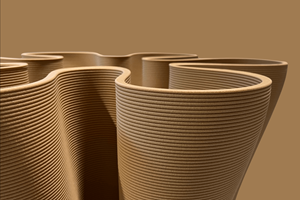Composites in transit: Rolling robotic “stuff carrier” the new must-have
PPF’s Gita can move at a human walking pace or can accelerate up to 35 kph, fast enough to keep pace with a runner.
What should hip urban dwellers do when they need to pick up a week’s groceries or carry a big briefcase of documents home from the office, but don’t own a car and can’t find a taxi or Uber (or an aerial drone)? Piaggio Fast Forward (PFF, Boston, MA, US) could have the answer. Founded in 2015 by the Piaggio Group, the maker of the iconic Vespa motor scooter and other two- and three-wheeled vehicles, PPF’s stated goal is to “create lightweight, intelligent and autonomous mobility solutions for people and goods.” Architectural composites innovator Greg Lynn, PFF’s co-founder and chief creative officer, saw a trend: “People were moving less, and more things were being brought to them. We see an alternative vision, where robotic solutions can help people move more, by carrying and following. It makes your hands free so you can do more with your hands, and you can walk or run further, longer.”
The first PFF product prototype, introduced in February of this year, is the Gita (pronounced “gee-ta,” Italian for “short trip”). Gita is a 0.67m diameter, smart, wheeled robotic cargo vehicle, with an 18-kg payload. Equipped with an optical detection system and sensors, it creates a three-dimensional map of its surroundings, with waypoints, while following a human, who wears a camera device. Once Gita knows a route, it can operate autonomously in some environments or in a convoy mode with other Gita devices, or in tandem with the Kilo, a larger PPF-designed robotic vehicle that has a 91-kg capacity.
Instead of streets filled with autonomous cars, PFF imagines people walking, biking or skating with their robots handling the heavy lifting. PPF’s Gita (pictured above) can move at a human walking pace or can accelerate up to 35 kph, fast enough to keep pace with a runner.
Lynn tells CW that PFF is currently building high-performance working prototypes of the Gita, and can’t yet discuss its industrialized production plans. But the company has 
built 12 prototypes, the first six in carbon fiber and six more in carbon fiber/fiberglass. Prototype composite tooling was created by Symmetrix Composite Tooling (formerly mould-CAM US, Bristol, RI, US) from machined foam patterns for the cylinder barrel, the domed cylinder ends, and cargo area or “column.” Parts were wet-laminated and vacuum-consolidated, some by New England Boatworks (Portsmouth, RI, US) and the rest by PFF, in-house. “We switched to fiberglass cover panels and cargo structure for the newer prototypes because we needed to have better transmission through areas of the vehicle for the electrical signals,” says Lynn.
Almost all other details, mounts and additional parts that bond to Gita’s body or structure are 3D-printed, carbon-reinforced nylon parts (some with chopped and others with continuous carbon fiber) built with in-house Markforged (Somerville, MA, US) printers, and other printers that also use chopped fiber in nylon, says Lynn. “We were able to very rapidly build working prototypes at a very high quality and with the weight and strength of production parts by working with the composites industry in the Bristol, RI area,” he adds, “as well as using the robotics we have in-house to make our own CNC-shaped molds and laminating our own parts in-house.”
Related Content
Plant tour: Teijin Carbon America Inc., Greenwood, S.C., U.S.
In 2018, Teijin broke ground on a facility that is reportedly the largest capacity carbon fiber line currently in existence. The line has been fully functional for nearly two years and has plenty of room for expansion.
Read MoreSulapac introduces Sulapac Flow 1.7 to replace PLA, ABS and PP in FDM, FGF
Available as filament and granules for extrusion, new wood composite matches properties yet is compostable, eliminates microplastics and reduces carbon footprint.
Read MoreInfinite Composites: Type V tanks for space, hydrogen, automotive and more
After a decade of proving its linerless, weight-saving composite tanks with NASA and more than 30 aerospace companies, this CryoSphere pioneer is scaling for growth in commercial space and sustainable transportation on Earth.
Read MoreCombining multifunctional thermoplastic composites, additive manufacturing for next-gen airframe structures
The DOMMINIO project combines AFP with 3D printed gyroid cores, embedded SHM sensors and smart materials for induction-driven disassembly of parts at end of life.
Read MoreRead Next
Ceramic matrix composites: Faster, cheaper, higher temperature
New players proliferate, increasing CMC materials and manufacturing capacity, novel processes and automation to meet demand for higher part volumes and performance.
Read MoreUltrasonic welding for in-space manufacturing of CFRTP
Agile Ultrasonics and NASA trial robotic-compatible carbon fiber-reinforced thermoplastic ultrasonic welding technology for space structures.
Read MoreNext-gen fan blades: Hybrid twin RTM, printed sensors, laser shock disassembly
MORPHO project demonstrates blade with 20% faster RTM cure cycle, uses AI-based monitoring for improved maintenance/life cycle management and proves laser shock disassembly for recycling.
Read More












